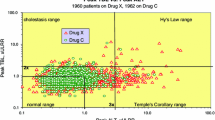Abstract
Issuing labeling changes is a common practice to warn about important side effects after drug approval. Among the many safety concerns, liver toxicity is frequently a major cause for postapproval labeling changes. To examine labeling changes associated with liver toxicity, safety-related labeling changes due to liver toxicity were reviewed. They were categorized into labeling changes that clarified/emphasized existing safety information and those that added new safety information. For labeling changes with new safety information, the preapproval safety data were reviewed to evaluate whether there was strong evidence of liver toxicity in the preapproval clinical data.
Thirty-five labeling changes were found to meet the selection criteria. Among them, 10 modified “Boxed Warning,” 24 modified “Warnings,” and 12 modified “Contraindications.” If categorized by nature, 22 changes clarified/ emphasized existing information and eight added new information on liver toxicity.
The review of the preapproval safety data of drugs with labeling changes that added new information on liver toxicity demonstrated that only seven events of mild liver toxicity were associated with atomoxetine, and for telithromycin, the rates of combined elevation of bilirubin and aminotransferases and of pure elevation of aminotransferases were comparable with the comparator.
In conclusion, after drug approval, labeling changes are occasionally issued to warn of liver toxicity. They clarified/emphasized existing liver toxicity information more often than added new information. For drugs not considered he-patotoxic initially but found to be associated with significant liver toxicity concern after drug approval, no strong evidence of liver toxicity could be noted in the preapproval data sets.
Similar content being viewed by others
References
Jacoby JL, Fulton J, Cesta M, et al. After the black box warning: dramatic changes in ED use of droperidol. Am J Emerg Med. 2005;23:196.
Willy ME, Manda B, Shatin D, et al. A study of compliance with FDA recommendations for Pemoline (Cyler®). J Am Acad Child Adolesc Psychiatry. 2002;41:765–790.
Smalley W, Shatin D, Wysowski DK, et al. Con-traindicated use of cisapride. JAMA. 2000;284: 3036–3039.
Walker AM, Bortnichak EA, Lanza L, et al. The in-frequency of liver function testing in patients using nonsteroidal anti-inflammatory drugs. Arch Fam Med. 1995;4:24–29.
Liang BA. FDA use of the black box warning: time for reevaluation as a safety tool. J Clin Anesth. 2002;14:561–563.
US Food and Drug Administration. Safely labeling changes. Available at: http://www.fda.gov/medwatch/safety.htm. Accessed October 28, 2006.
US Food and Drug Administration. Drugs@FDA. Available at http://www.accessdata.fda.gov/scripts/cder/drugsatfda/. Accessed October 28, 2006.
US Food and Drug Administration. Review report of atomoxetine. Available at: http://www.fda.gov/cder/foi/nda/2002/21-411_Strattera_medr_P3.pdf. Accessed October 28, 2006.
US Food and Drug Administration. Review report of atomoxetine. Available al: http://www.fda.gov/cder/foi/nda/2002/21-411_Strattera_medr_P4.pdf. Accessed October 28, 2006.
US Food and Drug Administration. Review report of telithromycin. Available at: http://www.fda.gov/cder/foi/nda/2004/21-144_Ketek_Medr_P4.pdf. Accessed October 28, 2006.
US Food and Drug Administration. Review report of telithromycin. Available at: http://www.fda.gov/cder/foi/nda/2004/21-144_Ketek_Medr_P6.pdf. Accessed October 28, 2006.
US Food and Drug Administration. Anti-Infective Drugs Advisory Committee in Joint Session with the Drug Safety and Risk Management Advisory Committee. Adverse Events of Special Interest: Hepatic Safety Overview. Available at: http://www.fda.gov/ohrms/dockets/ac/06/slides/2006-4266s1-02-07-%20Ketek-Rullo.pdf. Accessed April 14, 2007.
US Food and Drug Administration. 21 CFR 201.57. Available at: http://www.accessdata.fda.gov/scripts/cdrh/cfdocs/cfcfr/CFRsearch.cfm?CFRpart=201. Accessed April 14, 2007.
Beach JE, Faich GA, Bormel FG, et al. Black box warnings in prescription drug labeling: results of a survey of 206 drugs. Food Drug Law. 1998;53:403–411.
Willy ME, Li Z. What is prescription labeling communicating to doctors about hepatotoxic drugs? A study of FDA approved product labeling. Phar-macoepidemiol Drug Safety. 2003;13:201–206.
US Food and Drug Administration. Reviewer guidance—conducting a clinical safety review of a new product application and preparing a report on the review. Available at: http://www.fda.gov/cder/guidance/3580fnl.htm. Accessed October 28, 2006.
Senior K. New antibiotic relabeled after liver damage link. Lancet Infect Dis. 2006;6:471.
Author information
Authors and Affiliations
Corresponding author
Rights and permissions
About this article
Cite this article
Lin, YL. Changes in Warnings and Contraindications in Prescription Drug Labeling Due to Liver Toxicity. Ther Innov Regul Sci 42, 35–44 (2008). https://doi.org/10.1177/009286150804200107
Received:
Accepted:
Published:
Issue Date:
DOI: https://doi.org/10.1177/009286150804200107



